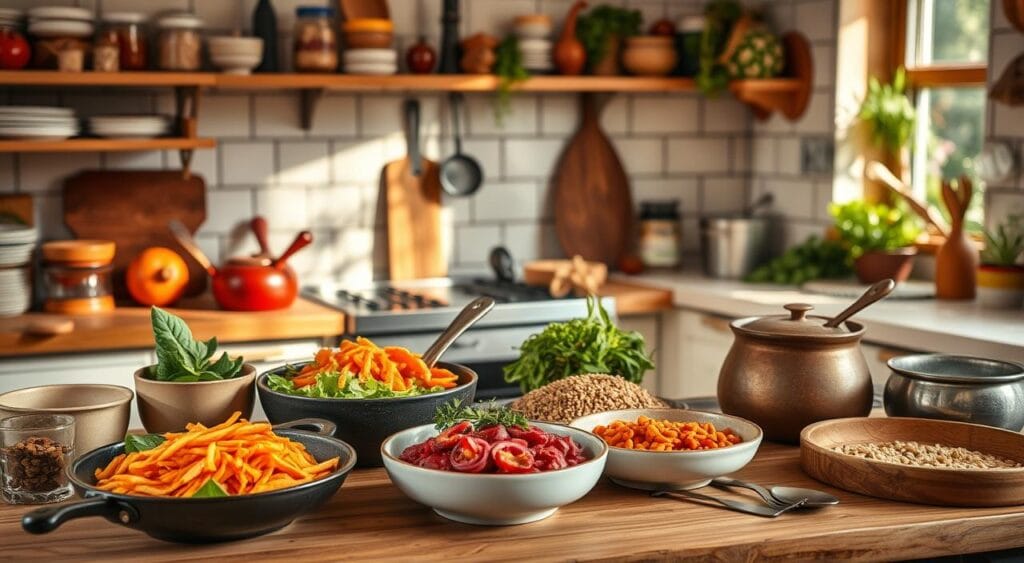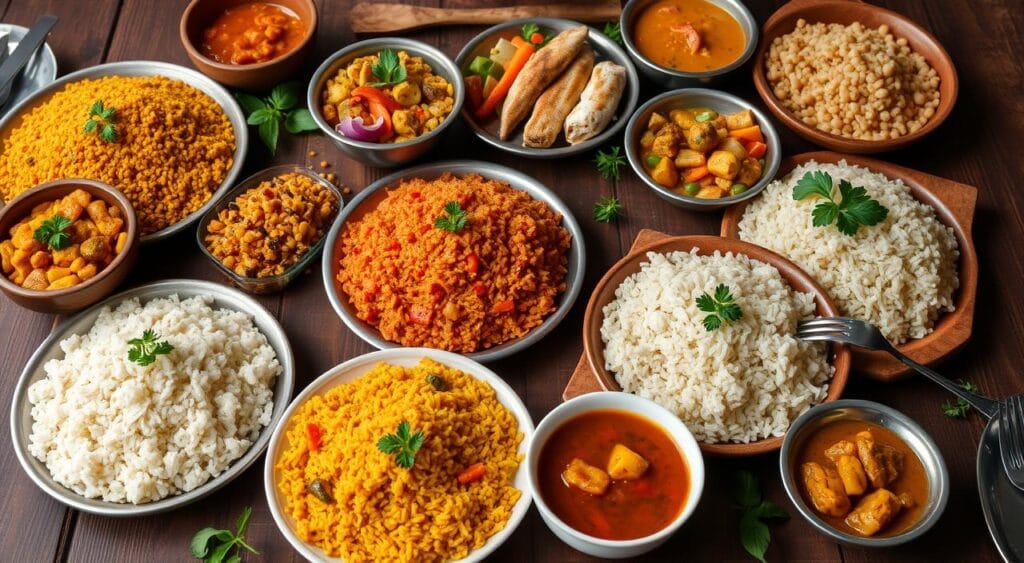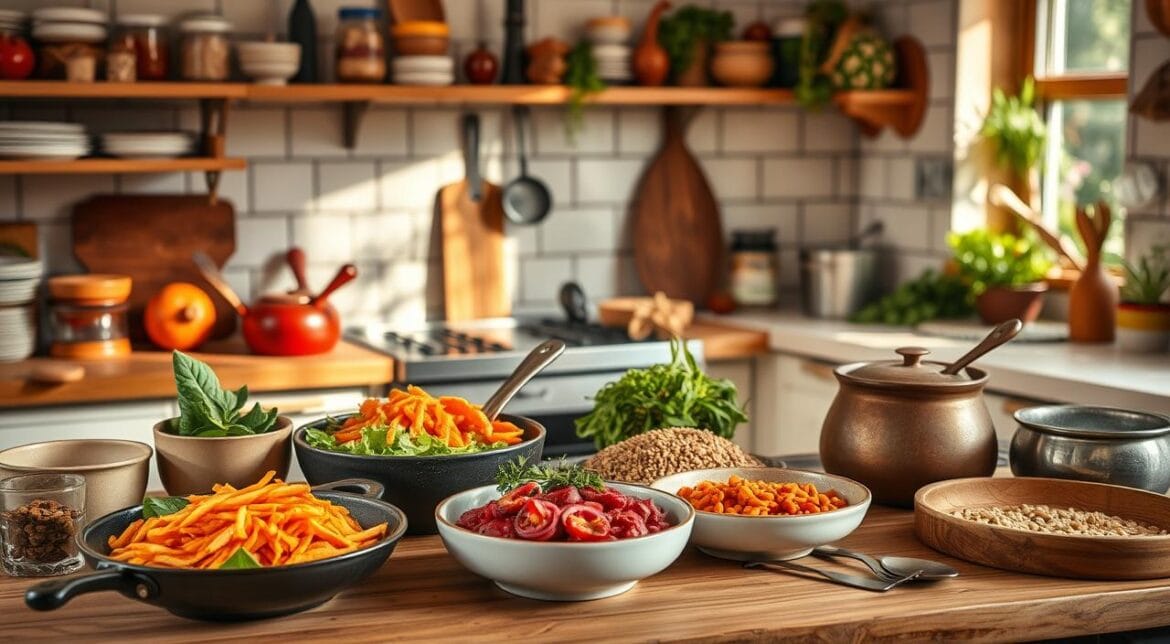Table of Contents
How to make simple dishes with Sajata recipe guide : Explore the world of Sajata, a traditional Bengali dish known for its rich flavors and easy preparation. Sajata is a favorite in many Indian homes, offering a unique culinary journey. This guide is for everyone, from experienced chefs to kitchen beginners, to make authentic and delicious Sajata dishes.
Sajata is Bengal’s comfort food, showcasing the region’s rich culinary heritage. It combines spices, fresh ingredients, and protein in a way that’s typical of Bengali cuisine. By learning how to make Sajata, you’ll enjoy its flavors and dive into Bengal’s cultural heritage.

Key Takeaways
- Discover the simplicity and flavor of traditional Sajata dishes
- Explore the cultural significance and origins of Sajata cuisine
- Learn about the essential ingredients and cooking methods for authentic Sajata preparation
- Equip your kitchen with the right tools and equipment for Sajata cooking
- Master the art of spice blending to elevate your Sajata dishes
Understanding the Essence of Traditional Bengali Sajata Cuisine
The traditional sajata cuisine comes from Bengal’s rich food heritage. It’s a seafood favorite among those who love regional Indian dishes. This cooking style shows off the coastal culture and the cleverness of the people.
Origins and Cultural Significance
The sajata cuisine started in Bengal’s coastal areas. The area’s fish and trade routes shaped its food traditions. Now, making sajata dishes is a big part of Bengali celebrations, showing the region’s love for the sea and seafood.
Key Ingredients in Sajata Cooking
The heart of sajata cuisine is the freshwater fish from Bengal’s rivers and estuaries. Some key fish include:
- Hilsa (also known as ilish), a prized bengali seafood delicacy
- Koi (climbing perch)
- Bhetki (Asian sea bass)
- Chitol (featherback)
Seafood is just the start. Sajata cuisine also uses spices, herbs, and aromatics. These add depth and complexity to the dishes. Ingredients like mustard oil, panch phoron, and fresh chilies are key.
Traditional Cooking Methods
Sajata dishes are made with slow-cooking techniques. This lets the flavors mix and the fish get a special texture. Cooking in a kolshi (brass or copper pot) adds to the dish’s authenticity.
“Sajata is not just a dish; it’s a culinary reflection of Bengal’s deep connection to its rivers and the abundance they offer.”
Learning about sajata cuisine helps us understand its importance. It shows the rich culture and traditions of Bengal.

Essential Kitchen Tools and Equipment for Sajata Preparation
Mastering Bengali cooking and east Indian seafood preparations needs the right tools. Whether you’re a pro chef or a home cook, the right utensils are key. They help get the right textures and flavors.
The kadai, a wok-like pan, is crucial for sajata prep. It’s great for stir-frying and simmering. This pan helps create the unique aromas and caramelized tastes of sajata dishes.
| Traditional Tools | Modern Alternatives |
|---|---|
| Kadai (Wok) Mortar and Pestle Spice Grinder Clay Pot (Handi) | Heavy-Bottomed Skillet Electric Spice Grinder Food Processor Ceramic or Cast Iron Baking Dish |
A mortar and pestle are key for grinding spices in sajata dishes. An electric spice grinder can also help get the spice mix right.
For slow-cooked dishes like fish curries, a handi (clay pot) is best. But, a heavy-bottomed ceramic or cast iron dish works well too.
With the right tools, you can dive into authentic Bengali cooking and east Indian seafood preparations. The world of sajata cuisine awaits.
Basic Ingredients for Authentic Sajata Recipe
Making a tasty Indian fish curry or spicy fish gravy needs the right ingredients. At the core of Sajata cooking are vibrant spice blends and fresh, aromatic produce. These give the dishes their unique flavors.
Spice Blends and Aromatics
The base of Sajata cooking is the balance of spices. Key spices are cumin, coriander, turmeric, chili peppers, and fenugreek. They’re mixed to create the Indian fish curry or spicy fish gravy smell. Herbs like curry leaves, cilantro, and mustard seeds add to the flavor.
Fresh Produce Selection
- Onions, tomatoes, and garlic are key in Sajata cooking. They add sweetness, acidity, and depth.
- Freshly grated coconut, whether fresh or frozen, makes the curries creamy.
- Green chilies, ginger, and other aromatic veggies are used in different regions.
Protein Options
Indian fish curry and spicy fish gravy are iconic Sajata dishes. But, the cuisine also uses other proteins. Freshwater fish like tilapia, rohu, or catfish are common. But lamb, chicken, and shrimp can also make tasty Sajata dishes.
| Ingredient | Role in Sajata Cuisine |
|---|---|
| Cumin, Coriander, Turmeric | Provides the signature spice blend |
| Onions, Tomatoes, Garlic | Creates the flavor base |
| Freshly Grated Coconut | Lends creaminess to the curries |
| Freshwater Fish (Tilapia, Rohu, Catfish) | The protein of choice for traditional Sajata dishes |
Choosing these key ingredients well lets home cooks make authentic Sajata dishes. They can create delicious Indian fish curry or spicy fish gravy dishes. These dishes take you to the heart of Bengal.
Mastering the Art of Spice Blending in Bengali Cuisine
Aromatic fish curries and traditional Bengali recipes are key to the region’s vibrant culinary traditions. The art of spice blending is at the heart of these dishes. It turns simple ingredients into a symphony of tastes. Mastering spice blending is essential to unlock the authentic flavors passed down through generations.
The foundation of a great spice blend for Bengali cuisine is finding the right balance. Warm, fragrant spices and bold, pungent seasonings are crucial. From cumin’s earthy undertones to chili peppers’ fiery kick, each spice plays a vital role.
Crafting the Perfect Spice Blend
To create a balanced spice blend for your traditional Bengali recipes, follow these guidelines:
- Start with a base of whole or ground cumin, coriander, and turmeric, adjusting the ratios to suit your personal preferences.
- Incorporate aromatic spices like cardamom, cloves, and cinnamon to add depth and complexity to the blend.
- Introduce a touch of heat with dried chili peppers or cayenne powder, but be mindful of the desired level of spiciness.
- Experiment with fenugreek, mustard seeds, and nigella seeds to infuse your spice blend with the quintessential flavors of Bengali cuisine.
- Adjust the quantities and proportions of each spice to achieve the perfect balance that complements the other ingredients in your dish.
The art of spice blending is a delicate dance. The key to mastering it is patient experimentation and understanding the flavors you’re aiming to create.
“The key to an authentic Bengali dish is the perfect harmony of spices, with each one adding its distinct aroma and flavor to the overall culinary experience.”
| Spice | Typical Proportion | Key Contribution |
|---|---|---|
| Cumin | 2 parts | Earthy, warm, and slightly nutty |
| Coriander | 2 parts | Citrusy, floral, and slightly sweet |
| Turmeric | 1 part | Vibrant yellow color and subtle bitterness |
| Cardamom | 1 part | Fragrant, slightly menthol-like aroma |
| Chili Powder | 1 part | Spicy heat and depth of flavor |
By mastering the art of spice blending, you’ll unlock the true essence of traditional Bengali cuisine. Your aromatic fish curries and other regional specialties will reach new heights of flavor and authenticity.
Step-by-Step Sajata Recipe Guide for Beginners
Start a flavorful journey into authentic Bengali cuisine with our step-by-step guide. This guide will help you make a classic sajata dish, whether you’re experienced or new. It’s designed to help you succeed in the kitchen.
Preparation Techniques
First, marinate your protein, like fish or shrimp, in yogurt, spices, and herbs. Allow it to sit for at least 30 minutes, or up to a few hours. This lets the flavors mix well.
While the protein marinates, make a spice mix. Use cumin, coriander, and mustard seeds. Grind them until they’re a fine powder.
Cooking Process
- Heat a lot of mustard oil in a big pan over medium-high heat. When it starts shimmering, add the marinated protein. Cook until it’s golden-brown on both sides.
- Lower the heat to medium. Add sliced onions, garlic, and ginger. Cook until they’re soft and smell good.
- Add the spice mix and a bit of water. Stir well to make a tasty sauce. Let it simmer for 15-20 minutes, until the protein is done and the sauce thickens.
- Put in fresh chopped tomatoes and a bit of sugar. This balances the acidity. Season with salt to taste.
Serving Suggestions
Serve your sajata dish hot, with fresh cilantro and lemon. It goes well with steamed basmati rice or warm naan bread. This makes for a complete Bengali meal. Enjoy the rich flavors and the cozy feel of this traditional dish.
Advanced Tips for Perfect Sajata Fish Curry
To make your indian fish curry taste like it’s from a restaurant, you need to know some secrets. Choosing the right fish and balancing flavors are key. These tips will help you make a delicious Sajata fish curry.
Choosing the Right Fish
The quality of your seafood is crucial for a great Sajata fish curry. Pick firm, fresh fish like carp, rohu, or hilsa. They keep their shape and soak up the spices well. Stay away from soft, flaky fish that might fall apart.
Achieving the Perfect Curry Consistency
The curry’s smooth texture is essential. Cook the fish slowly in a mix of spices, yogurt, and coconut milk. This lets the flavors blend and the gravy thicken just right. Don’t hurry it; patience is important for a perfect curry.
Balancing Flavors
A great Sajata fish curry has a mix of sweet, sour, spicy, and umami. Play with the amounts of mustard oil, tamarind, green chilies, and jaggery. Find the right mix that excites your taste buds.
Regional Variations
Try different versions of Sajata fish curry from across Bengal. From the bold Kolkata-style to the creamy coastal ones, there’s a lot to explore. Adapt the recipe to your liking.
With these advanced tips, you’ll get better at making a bengali seafood delicacy. Your indian fish curry will transport you to the heart of traditional Indian cuisine.
Common Mistakes to Avoid When Cooking Sajata Dishes
Preparing authentic Bengali cooking dishes like the flavorful spicy fish gravy is a fun experience. However, it comes with its own set of challenges. Knowing the common mistakes can help you avoid them and make sure your dishes are perfect every time.
Temperature Control Issues
Keeping the right temperature is key in sajata cooking. If the heat is not controlled, your dish might end up overcooked or undercooked. Always watch the temperature and adjust it to get the perfect doneness for each part.
Seasoning Errors
Sajata dishes are famous for their complex spice and seasoning mix. Getting the seasoning just right can be hard. Be careful with the spice amounts and when to add them. Taste your dish often to adjust the seasoning as needed.
Texture Problems
The texture of sajata dishes is very important. You want the fish to be flaky and the gravy to be smooth. If you overcook or don’t mix the ingredients well, the texture will be off. Follow the recipe closely and watch for visual and touch cues to get the right texture.
By avoiding these common mistakes, you’ll be on your way to making authentic Bengali cooking. Your spicy fish gravy and other sajata dishes will truly shine.
Seasonal Variations and Ingredient Substitutions
Exploring regional Indian dishes and east Indian seafood is a fun journey. It’s filled with exciting flavors and true traditions. These dishes change with the seasons, letting cooks use local ingredients while keeping the dish’s spirit.
Sajata recipes from Bengal show how to adapt to the seasons. By knowing how to mix ingredients and cooking methods, you can make dishes that reflect your area’s harvest and the season’s mood.
Embracing Seasonal Bounty
In summer, markets are full of mangoes and greens. You can add these to your Sajata dishes. Use fresh, sustainable east Indian seafood to make a light, cool fish curry.
- Try using tender fish like tilapia or halibut instead of river fish.
- Add summer veggies like okra, eggplant, or tomatoes for color and flavor.
- Use cooling spices like fennel, cumin, or fenugreek to cool down the dish.
As seasons change, so can your Sajata recipes. Use autumn and winter’s root veggies, lentils, and squash for hearty, comforting dishes that celebrate local flavors.
Ingredient Substitutions with Authenticity
Exploring regional Indian dishes lets you try new ingredients while staying true to the cuisine. If you can’t find something traditional, get creative. Find substitutes that keep the dish’s essence.
| Traditional Ingredient | Potential Substitutions |
|---|---|
| Mustard Oil | Peanut Oil, Sesame Oil, or Avocado Oil |
| Panch Phoron (Whole Spice Blend) | Cumin, Fennel, Fenugreek, Mustard, and Nigella Seeds |
| Freshwater Fish | Sustainable Cod, Tilapia, or Halibut |
By using seasonal ingredients and smart substitutions, you can dive deeper into regional Indian dishes and east Indian seafood preparations. You’ll keep the traditions of Sajata cuisine alive.
Health Benefits of Traditional Sajata Cooking
Enjoying traditional Bengali sajata cuisine is a treat for your taste buds and your health. These recipes, passed down through generations, are not just tasty but also packed with nutrients.
Nutritional Value
Sajata dishes are known for their balanced mix of nutrients. They combine proteins, healthy fats, and spices, making each bite full of vitamins, minerals, and antioxidants. Whether it’s protein-rich fish curries or fiber-filled veggies, sajata cuisine meets many dietary needs.
Dietary Considerations
- Gluten-free: Many traditional Bengali recipes are naturally gluten-free, making them great for those with gluten sensitivities or celiac disease.
- Heart-healthy: Healthy fats like mustard oil and ghee, along with omega-rich fish, support heart health.
- Diabetes-friendly: Sajata dishes balance carbs, proteins, and fiber, which is good for diabetes management.
- Anti-inflammatory: Spices like turmeric and ginger in sajata cuisine help reduce inflammation and support well-being.
Exploring sajata cuisine is a joy for your taste buds and a way to nourish your body and mind. Adding these healthy and flavorful dishes to your diet can lead to better health and a deeper connection with culture.
Pairing Suggestions and Accompaniments
Enjoying the rich flavors of Bengali seafood delicacy is better with the right sides. Find the perfect pairings for your authentic Bengali cooking. This will make your meal harmonious and satisfying.
Complementary Rice Varieties
Basmati rice is the classic choice for sajata dishes. Its fragrant and light texture lets the curry flavors shine. For a traditional touch, try kalo ghror, a short-grained rice used in Bengali cuisine.
Flavorful Side Dishes
- Lightly sautéed seasonal vegetables, like lau (white pumpkin) or shukto (mixed vegetables), offer a refreshing contrast to the sajata’s richness.
- A cooling raita, with yogurt, cucumber, and spices, balances the curry’s heat.
- For a heartier side, try dal (lentil stew) or aloo posto (potatoes in poppy seed sauce).
Beverage Pairings
Pair your Bengali seafood delicacy with a refreshing mishti doi (sweet yogurt) or aam panna (raw mango cooler). These traditional Bengali drinks cool the palate and enhance the dining experience.
“The true essence of authentic Bengali cooking lies in the harmonious interplay of flavors and textures. By thoughtfully selecting the right accompaniments, you can unlock the full potential of your sajata dishes.”
Conclusion
Exploring traditional Bengali sajata recipes has shown you their cultural importance and taste. You’ve learned about sajata’s origins, the mix of spices, and cooking techniques. Now, you understand the heart of this food heritage.
With this guide, you can make sajata dishes at home. You can try new spice blends, pick fresh ingredients, and improve your curry-making skills. Mastering these recipes brings great joy.
Keep exploring sajata dishes with patience and care. Appreciate the traditions behind this cuisine. With what you’ve learned, you can improve your cooking and share authentic sajata recipes with your family. Enjoy the cultural richness and flavors of sajata cooking.
FAQ
What is Sajata, and what makes it a unique dish in Bengali cuisine?
Sajata is a beloved Bengali fish curry. It’s known for its aromatic, spicy, and flavorful gravy. This is made with fragrant spices and fresh pastes.
The dish highlights Bengal’s seafood and the creativity of local cooks. They make delicious dishes from these ingredients.
What are the key ingredients used in Sajata recipes?
Sajata needs fresh fish like catfish, hilsa, or prawns. It also requires spices like cumin, coriander, and chili. Onions, garlic, and ginger add to the flavor.
Coconut milk or yogurt makes the gravy rich and creamy.
How do the traditional cooking methods of Sajata differ from other Indian fish curries?
Sajata is cooked slowly to blend flavors. This method tenderizes the fish and balances the spices. Whole spices and ground masalas are key to its taste.
What type of kitchen equipment is typically used for preparing Sajata?
A heavy-bottomed kadai or wok is used for Sajata. It ensures even heat and the right gravy texture. Tools like a mortar and pestle, sharp knife, and slotted spoon are also essential.
How can I ensure I achieve the perfect flavor balance in my Sajata dish?
For perfect flavor, choose the right spices. Use cumin, coriander, chili, and turmeric in the right amounts. Fresh seafood and aromatic ingredients like onions, garlic, and ginger are also important.
What are some common mistakes to avoid when cooking Sajata?
Avoid overcooking the fish to prevent toughness. Use the right temperature and cooking time for a good gravy. Proper seasoning is also crucial to avoid blandness or too much spice.
How can I adapt Sajata recipes to incorporate seasonal ingredients or dietary preferences?
You can use different fish or seafood based on what’s in season. Try substituting coconut milk with yogurt for a tangier taste. Adjust spice levels and add more vegetables to suit your taste and diet.
What are the health benefits associated with traditional Sajata cooking?
Sajata is healthy because it uses fresh ingredients. The seafood is a good source of protein. The spices and herbs add antioxidants and anti-inflammatory properties.
Coconut milk or yogurt adds healthy fats and probiotics. This makes Sajata a nutritious meal.
How can I pair Sajata dishes with other traditional Bengali dishes for a complete meal?
Serve Sajata with steamed white rice or basmati rice. Try it with pickled vegetables, chutneys, and papadums. Pair it with dal, aloo posto, or raita for a complete meal.


2 comments
[…] Posts How to make simple dishes with Sajata recipe… Easy Sajata recipe ideas for beginners Recipe for Crumpets with Caviar: A Gourmet Twist… Crumpet […]
[…] Posts Top Sajata recipe tips for healthy cooking How to make simple dishes with Sajata recipe… Easy Sajata recipe ideas for beginners Recipe for Crumpets with Caviar: A Gourmet Twist… Crumpet […]
Comments are closed.